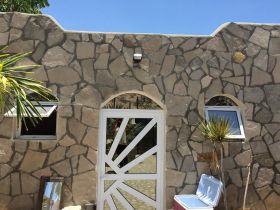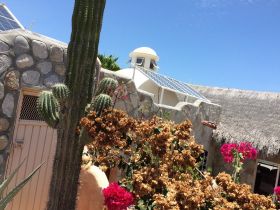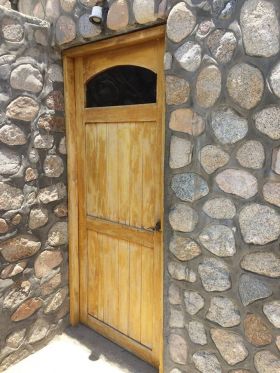Bill Edsell on the Physics of Coolness in the Baja California Sur Summers and the Beauty of Domes
 In this interview, Bill Edsell, of La Ventana Resorts, explains to Jet Metier how to keep buildings cool in Baja California Sur
In this interview, Bill Edsell, of La Ventana Resorts, explains to Jet Metier how to keep buildings cool in Baja California Sur Jet: Here we are, in early July, sitting in the main room of your resort, in La Ventana, about an hour southeast of La Paz, on the Sea of Cortez. The roof is a palapa. It’s about two o’clock in the afternoon and it’s not uncomfortable. You’ve got a stone fireplace and then I guess these are cement blocks. Did you choose the stone for esthetics or are you using the stone to keep this part of the palapa cool?
Bill: We don’t have air conditioning here in this room but all the rooms have AC. Here we have fans. It’s not many times that it gets too hot here because of the palapa, plus the airflow. The airflow is a huge factor, and here, it naturally wants to funnel through.
Jet: I wanted to ask you about that because we visited some of our neighbor’s homes and they don’t have windows all throughout their homes.
 Bill: Yeah; that’s a mistake. People just don’t understand the importance of airflow and windows, and architects, amazingly, don’t worry about that stuff. They’ll say, “Just put in a bigger air conditioner.”
Bill: Yeah; that’s a mistake. People just don’t understand the importance of airflow and windows, and architects, amazingly, don’t worry about that stuff. They’ll say, “Just put in a bigger air conditioner.” I use air conditioning when I need it, but I hate it. It’s not healthy. It drives me crazy. You go to the offices here and in the banks in La Paz, where everybody’s got their suits on and their sweaters and they got the thermostat set to 65 degrees. You walk in on a 100-degree day and you’re freezing.
Jet: How do you design a house to be cool with the proper airflow?
Bill: The winds are changing all the time, but the basic winds are pretty simple. In the winter, during the day, they blow from the north and out of the northwest. At night, the winds switch, and come down off the mountains and it’s cool.
So that wind off the mountains is a cool wind that sometimes you want, and sometimes you don’t want. In January when it’s cold you don’t want that. That’s why it’s open here now in July but we can close it if we want to. It stays very nice here in January when it’s cool, but in the summer, the winds are blowing straight off east. That’s our typical wind we get all summer; not every day but  pretty constant. You want to create that flow through your house. It’s only at daytime, unfortunately. You’ll feel it stop at about 6 o’clock. So yes, you want that flow coming through in the summer.
pretty constant. You want to create that flow through your house. It’s only at daytime, unfortunately. You’ll feel it stop at about 6 o’clock. So yes, you want that flow coming through in the summer.
 pretty constant. You want to create that flow through your house. It’s only at daytime, unfortunately. You’ll feel it stop at about 6 o’clock. So yes, you want that flow coming through in the summer.
pretty constant. You want to create that flow through your house. It’s only at daytime, unfortunately. You’ll feel it stop at about 6 o’clock. So yes, you want that flow coming through in the summer. Jet: And then what do you do after 6 o’clock? Do you put the air conditioning on?
Bill: It depends on the room. If the room’s really heated up and if you have exposed walls, especially the blocks, you may need air conditioning. The exposed blocks absorb so much sun, it will radiate all night. You’ll notice that here, we have no exposed walls.
Jet: What about your other rooms?
Bill: In the summer, the sun is to the north, so that means your north wall can potentially get sun. So you don’t have to worry about your south wall. And in the winter, it’s cold. You actually want some warmth. So you don’t worry about insulating your south wall.  And in your north wall, because the sun doesn’t go too far to the north, it depends on the angle. For example, this wall doesn’t get much sun and we put a rock face on it, too, so we’re not really getting any heat there.
And in your north wall, because the sun doesn’t go too far to the north, it depends on the angle. For example, this wall doesn’t get much sun and we put a rock face on it, too, so we’re not really getting any heat there.
 And in your north wall, because the sun doesn’t go too far to the north, it depends on the angle. For example, this wall doesn’t get much sun and we put a rock face on it, too, so we’re not really getting any heat there.
And in your north wall, because the sun doesn’t go too far to the north, it depends on the angle. For example, this wall doesn’t get much sun and we put a rock face on it, too, so we’re not really getting any heat there. Jet: And why do you have a rock there?
Bill: It’s cosmetic but it does help insulate. Because we have the palapa roof you’re not getting any sun absorbing into anything here. On that side, you get the afternoon sun, which contain probably the two most important walls that you want to protect, either by insulating them or using a foam block; something that doesn’t absorb heat. There are a lot of materials out now that you can use.
East and west, that’s where you’re going to get the most sun. So either you do patio areas covered to protect your walls, or use a foam. We haven’t actually used the foam blocks, but I understand that there are 2 or 3 different factories making them. But we use this W Panel. It comes in various thicknesses and has a metal mesh over it. You can build a structural wall with it. You don’t even need support; it is its own support. W Panel reduces a lot of heat because it doesn’t absorb the heat like these concrete blocks,  which are the worst.
which are the worst.
 which are the worst.
which are the worst. Jet: Please explain to me how the domes work in keeping the rooms and the houses cool and how many should you have.
Bill: In order to close the openings in them, you can get mechanisms; even electric mechanisms ones. Relative to us here, we’re not constantly opening and closing them. We close them in the winter when it’s cold, and we open them in the summer and we close them in hurricanes. So the gardener just goes up there and closes them.
Jet: He climbs on the outside?
Bill: Yeah.
Jet:. And how much cooler is that room as a result of having the dome’s windows open?
Bill: You can go up there and you’ll feel the heat coming out, because it’s like a chimney.
But the domes aren’t particularly cool in their material. The beauty of the domes is the ventilation effect and that the place where the sun hits the dome is moving on a round surface. For example, on a flat roof you’re getting sun the whole day, but with a dome, there is always a shaded area, and that area changes. When the sun is on one side, the other side is shaded. As the sun moves, a different area is shaded. So the dome is creating its own shade.
Jet: You mentioned the ventilation effect. What do you mean by that?
Bill: Well, the air goes up like a chimney so it kind of draws the air up. That’s why they’re so nice in kitchens. If you’re cooking, the smoke or smells or whatever will get sucked up through the cupola.
Jet: To keep things cool, do you need to have a dome over each room or just one part of the house?
Bill: I didn’t do the domes because of the climate. I did them because they’re different, they’re very Mexican, and they’re handmade. I wanted to do something different. I was thinking to do palapa because that’s obviously very Mexican but I thought, “No, not for the rooms.” People may worry if they see a scorpion.
There’s an Iranian architect who teaches in a university north of LA who is a very interesting guy. He actually helped NASA design a construction on the moon. He’s just completely out of the box. He came up with this idea of building with clay. You would build your structure and then use like a giant flamethrower that would cook the house, just like you would cook ceramic in a kiln, but this is like cooking the house from the inside out like a kiln.
I had a friend who was trying to do this using dome so I started studying and found these ancient domes and kilns in Iran. All the new buildings were falling down in the earthquakes and these things weren’t. Somehow it got me interested in domes. You don’t see them much here but if you go to Mexico City, the old colonial cities, you’ll see a lot of domes and of course in Spain and Morocco and so on.
I knew that domes would help a little bit with heat because of the ventilation but I built using domes more for esthetic reasons. For example, when you sit under them, it’s just like here; your eye goes to them. I think it’s because they’re handmade, as well. It’s something that pulls your eye to it. You could probably build them with more insulation to help with the heat but they’re not bad as is, and they’re certainly much better than a flat roof.
Jet: Lastly, what about building a second story? They’re very hot and stuffy. Do you have any two-story houses?
Bill: You’re right there. You know the trick to building with a second story? You use a palapa. That’s the most sensible thing. With a palapa, you’re keeping your top floor cool so your bottom floor is going to stay cool, too.
You look at some of these things that people build in this area and you ask yourself, “What were they thinking?” Some people just don’t put any thought into it or depend on the architect or whoever’s doing it. I don’t work with an architect. I work with an engineer and I show them what I want because sometimes these architects want to do it the way they want, but they don’t seem to pay much attention to designing around their local climate. You could build some of the box-like houses you see here anywhere, and just putting in a bigger air conditioner or a bigger heater, that’s how they solved their problems. Instead, they should think about the natural climate.



.png)